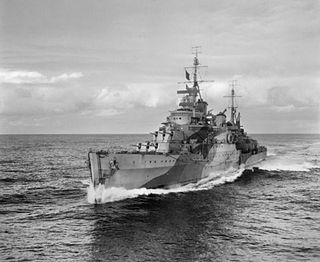| Ordnance BL 8 inch gun Mk VIII | |
|---|---|
Forward 8-inch turrets aboard HMAS Canberra | |
| Type | Naval gun Coast defence gun |
| Place of origin | United Kingdom |
| Service history | |
| In service | 1927 – 1954 [1] |
| Used by | Royal Navy Royal Australian Navy |
| Wars | Second World War |
| Production history | |
| No. built | 168 [2] |
| Specifications | |
| Weight | 17.5 tonnes [2] |
| Barrel length | 400 inches/10 meters(50 calibres) [2] |
| Shell | 256 pounds (116 kg) |
| Calibre | 8-inch (203 mm) [2] |
| Muzzle velocity | 2805 feet per second (855 m/s) [2] |
| Maximum firing range | 28 kilometres (17 mi) [2] |
The 50 calibre BL 8 inch gun Mark VIII [note 1] was the main battery gun used on the Royal Navy's County-class heavy cruisers, [note 2] in compliance with the Washington Naval Treaty of 1922. This treaty allowed ships of not more than 10,000 tons standard displacement and with guns no larger than 8 inches (203 mm) to be excluded from total tonnage limitations on a nation's capital ships. The 10,000 ton limit was a major factor in design decisions such as turrets and gun mountings. A similar gun formed the main battery of Spanish Canarias-class cruisers. [3] In 1930, the Royal Navy adopted the BL 6 inch Mk XXIII naval gun as the standard cruiser main battery in preference to this 8-inch gun. [4]

The Royal Navy (RN) is the United Kingdom's naval warfare force. Although warships were used by the English kings from the early medieval period, the first major maritime engagements were fought in the Hundred Years War against the Kingdom of France. The modern Royal Navy traces its origins to the early 16th century; the oldest of the UK's armed services, it is known as the Senior Service.

The County class was a class of heavy cruisers built for the Royal Navy in the years between the First and Second World Wars. They were the first post-war cruiser construction for the Royal Navy and were designed within the limits of the Washington Naval Treaty of 1922. Such ships, with a limit of 10,000 tons, standard displacement and 8-inch calibre main guns may be referred to as "treaty cruisers".

The heavy cruiser was a type of cruiser, a naval warship designed for long range and high speed, armed generally with naval guns of roughly 203 mm (8 inches) in caliber, whose design parameters were dictated by the Washington Naval Treaty of 1922 and the London Naval Treaty of 1930. The heavy cruiser is part of a lineage of ship design from 1915 through the early 1950s, although the term "heavy cruiser" only came into formal use in 1930. The heavy cruiser's immediate precursors were the light cruiser designs of the 1900s and 1910s, rather than the armoured cruisers of before 1905. When the armoured cruiser was supplanted by the battlecruiser, an intermediate ship type between this and the light cruiser was found to be needed—one larger and more powerful than the light cruisers of a potential enemy but not as large and expensive as the battlecruiser so as to be built in sufficient numbers to protect merchant ships and serve in a number of combat theaters.




























